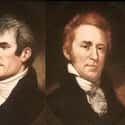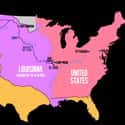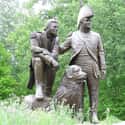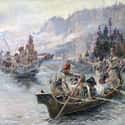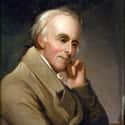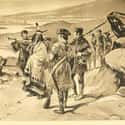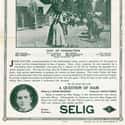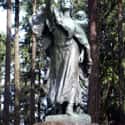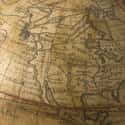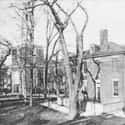-
(#1) They Ate Candles To Keep From Starving
Though the expedition was well-provisioned from the start, supplies ran low by the time the group approached the Bitterroot Range of the Rocky Mountains. It was winter, so the expedition's usual method of supplementing supplies with hunting and fishing was impossible. The men grew desperate, and resorted to eating tallow candles. Between the harsh weather and hunger, the entire Corps of Discovery nearly perished.
What they didn't know at the time was they were being watched by a group of Nez Perce tribal scouts and warriors, most of whom were quite keen to finish off the suffering men and take any belongings that might be useful or valuable. According to Nez Perce oral tradition, Watkuweis, a woman in the tribe, insisted on helping the strangers. She had not long before been kidnapped by an enemy tribe, and white men rescued and returned her to her home. "Do them no hurt," she demanded.
And so the Corps was saved by the word of a woman. But this was not the first time for that to happen.
-
(#2) Once The Expedition Left US Jurisdiction, It Became Fully Egalitarian
Once the expedition moved out of official US territory, their laws were of their own choosing. Every member of the Corp had a vote, no matter the decision or activity.
York, the only married man, and only African-American in the Corp, was William Clark's slave. At least, back home he was. But beyond US jurisdiction, he was a free man and became a major and highly valued member of the Corp.
Sacajawea was a pregnant, teenage Shoshone woman. In the States, those three qualities would have gotten her nowhere. But out on the trail, she was the expert, saving lives and property on a number of occasions. Her knowledge and grace earned her full respect among the Corp. She, too, was a leader, held her own vote, and made her own decisions. None of these things would have been possible in the US.
Even the enlisted members of the Corp, all young, white men, had opportunities beyond comprehension as they moved and learned along the trail. They were all country boys, few from great means, but their journey broadened and enlightened their minds in ways they never would have achieved had they stayed back home.
As a unit, the Corp worked together in kindness and respect for one another, no matter one's origins, status, or ethnicity. The journey was not without flaws, but those facts alone make the expedition an exceptional standout in all of American history.
-
(#3) Despite A Treacherous Journey, Only One Member Was Lost
When you consider the unimaginable risks and dangers undertaken by the Corp of Discovery, that it suffered only one casualty is remarkable. But such was the case.
Only three months into the journey, young Sergeant Charles Floyd became ill with nausea and severe abdominal pains. Lewis and Clark were particularly fond of the young man, as he was the first to apply for the job, was rigorously fit, and better educated than most of his fellow Corpsmen. The two leaders even agreed to grant Floyd the rank of sergeant before the journey began. So everyone was surprised someone of so many fine qualities and great health would be the first to falter.
The members of the Corp knew they were heading into harm's way when they joined up, but they figured their lives were mostly at risk from wild animal attack or skirmishes with angry tribal people.
Alas, there was no help for Sergeant Floyd. His suffering only worsened. William Clark sat up all night long watching over and trying to help the young man. Lewis recorded in this journal that, on August 15, after seeming to recover a bit, Floyd was “seized with a complaint somewhat like a violent chorlick [colic]… [and] he was sick all night.” On the afternoon of August 19, Floyd passed away, according to Lewis, "with composure."
Ironically, even if Floyd had somehow been magically transported to the finest doctors in Philadelphia, none of them could have saved him. He likely died from a burst appendix, and in the early 19th century, that was a death sentence, no matter one's location.
Members of the expedition buried Floyd on a high bluff overlooking the Missouri River, placing a red cedar marker at his grave site that stated his name, title, and life dates. The men were so moved by their unexpected loss they recorded Floyd River and Floyd Bluff on a new map drawn by Lewis.
Over the next more than two years the Corps of Discovery lost no other members to death.
-
(#4) Corp Men Had Plenty Of Sex With Native Women, Who Really Liked The One Africa-American Member Of The Expedition
A number of native women on the trail were interested in spending time with the exotic Americans strolling about their territory. Sexual activity, which, while welcomed by most of the Corpmen, was a bit shocking. Local traditions were very different from those of the sexually repressed European-American society in which the men grew up.
Some tribes believed sexual relations between their women and the strangers was a way to unite diverse people into one tribe. Pre-marital sex was no big deal. Lewis's and Clark's journals include passages about Mandan and other tribal leaders bringing several women to the Corp's captains and their men, offering them as gifts for the night.
Some leaders and women believed the mysterious strangers, who were so different from themselves, held special powers. This was especially true with regard to York, whose darker skin, according to the tribal people, indicated great physical and mental powers. It was believed a woman could retain these powers through intercourse, and pass them to her husband during sex.
On at least one occasion, a member of the expedition had sex with a married woman without consent or knowledge of her husband. When the husband found out, he stabbed the crap out of the guy, and Clark made the man give the husband trinkets to work the situation out.
There are stories of children born to these women as a result of their contact with men of the Corp. It seems likely to be the case; after all, the Corp spent the entire, snowy winter bunked down with Mandan people. Unfortunately, most of the men picked up venereal diseases from their new paramours.
-
(#5) Tribal Teenagers Stole Meriwether Lewis's Dog
Meriwether Lewis purchased a Newfoundland puppy while preparing for the journey. For more than a century, scholars were confused about the dog's name, which appears only once in Lewis's journal (typically, he referred to it as "my dog"), but this one iteration was written near the bottom of the page, and got smudged. At some point historians decided the dog's name was Scannon, but were clueless to the meaning.
Actually, Lewis's beloved pet was named Seaman, which is appropriate for a member of a breed known for a love of swimming and often trained to rescue those in distress. On many occasions, Seaman saved Corp members from drowning. Once, though, Lewis saved Seaman. Lewis reported in his journal that a beaver attacked Seaman, severing an artery in his leg. He wrote in his journal, “It was with great difficulty that I could stop the blood; I fear it will yet prove fatal to him.” The dog recovered.
Seaman was very popular with the Corp. He was petted and spoiled with treats. He was also very protective, barking and warning those he suspected might harm the Corp. When the men at long last encountered their first grizzly bear, Seaman had to be held back from attacking the enormous creature. He once chased a bull buffalo away from a tent where Corp members were sleeping. He was close to Sacajawea and her baby, John Baptiste, and allowed the little boy to crawl on and around him.
One thing Seaman did not care for was the massive clouds of mosquitoes that plagued the Corp on certain parts of their expedition. He would always seek a pond, creek, or river from which to escape the infernal bites from the pests.
A number of the tribal people the Corp encountered on their western trek were impressed with the enormous, shaggy-coated dog. One man from a tribe along the Columbia River unsuccessfully offered Lewis three beaver pelts for Seaman. On another occasion, some local tribal youth stole the dog during cover of darkness. Lewis was incensed when he discovered Seaman missing, tracked down the guilty parties and threatened to burn their village to the ground if they did not return his dog immediately.
Not much is known about Seaman after the expedition. However, in a book published in 1814, a well-known educator claims to have visited a museum with a large dog's collar bearing the inscription: "The greatest traveller of my species. My name is SEAMAN, the dog of captain Meriwether Lewis, whom I accompanied to the Pacifick ocean through the interior of the continent of North America."
Apparently Seaman never learned to spell.
-
(#6) Clark's Slave York Was A Free Man On The Expedition, But Expected To Return To Slavery Thereafter
York was the only married man and the only African-American member of the Corp of Discovery. He was also a slave. He and Clark had grown up together, but he was Clark's property. In fact, York didn't want to go on the expedition, preferring to stay behind with his wife and children. None of the other members of the Corp could have even applied for the position as a married man. But, because York was slave, his feelings didn't matter.
As he journeyed along the trail, York became one of the most valuable members of the Corp, respected for his knowledge, diplomacy, and other skills. Once the Corp traveled outside US jurisdiction, York was a free man. In this position, he, along with all other members of the expedition, was allowed to vote on decisions made by the group. He also proved himself a capable and reliable leader.
York was such a favorite among the native people the Corp encountered he was usually brought forward at the first meeting with a tribe, standing with Lewis and Clark. Most natives viewed York's stature and dark skin as symbols of great power. The ladies of the tribe were enamored with him.
As long as York was out on the expedition, he was able to live as a free man. When the Corp returned from its journey, every man except York was given significant acres of land as well as monetary compensation. York received nothing, and was expected to happily return to life as a slave.
The journey changed York. Clark didn't appreciate this. He complained of York getting "uppity," and recounted punishments including beating and jailing. York didn't care what Clark did to him, he continued to insist his freedom was the least Clark could do for him after all they had been through.
Historians are not sure as to York's fate. According to some, Clark sent him to Kentucky so he could be nearer his wife, who had a different owner. There are accounts of Clark granting York's freedom, and York owning a business, and stories in which he was freed but later regretted it (which sounds like some nonsense made up by a pro-slave lobby). Another account places York in Wyoming, as a prominent member of the Crow tribe.
-
(#7) Founding Father Benjamin Rush Gave Them Medicine Balls With Mercury For Regular System Cleanses
Dr. Benjamin Rush was a Founding Father and renowned physician. Lewis visited him before the journey, and Rush instructed him on how to set a broken limb, pull a tooth, and keep a patient comfortable, though he didn't have much to offer in the way of cures and medicine. It was hard to predict what the Corp might encounter, harder still to treat it far from home. Still, Rush offered a basic, often effective, cure-all. It came in the form of small, herbal medicine balls. Lewis took along hundreds of them to help cure whatever was ailing members of the Corp of Discovery.
Essentially, Rush's balls were powerful laxatives with small doses of mercury. Purges were a favorite cure of physicians in the 18th and 19th centuries, and Rush figured a good cleaning out of anyone who fell sick on the trail was the best cure. The Corp used up every single ball during the expedition, and referred to them as "Rush's Thunderbolts."
-
(#8) People Back East Thought They Were Dead
The Corp expedition lasted longer than two years. Back east, nothing had been heard from the group, other than the August 1806 arrival in Washington, DC of a wagon filled with some findings of the first leg of the expedition. A good many people feared the worst. Articles appeared in newspapers suggesting Lewis, Clark, and the rest were dead. Such stories fueled fantasies of death by Indians, bears, drowning, and strange tortures and rituals practiced against the Corp by native people.
-
(#9) At Least One Corp Member Returned To The West For Weird Adventures
It's been said by some that wherever an individual transitions from youth to adulthood, so they will always long to return. This is also true of those who go through transformative experiences far from home. There are stories of soldiers from the Vietnam War who felt they had grown up there, and that it would always feel at least somewhat like home.
Such was the case of John Colter, member of the Corp. He returned home with the rest of the expedition, but soon went west again, not in an official capacity, but as an explorer. Colter essentially wanted his old job back. He soon met two trappers in what is now Yellowstone Park. He worked with them for a while, and helped establish a trading post.
Due to his experience with wilderness travel and negotiating with natives, he was asked to alert area tribes to new trading opportunities. Little did Colter know he was embarking on a tour of gysers, waterfalls, boiling mud pots, and thermal springs. He became lost, and, to keep warm on cold nights, took to sleeping in thermal pools. He sustained severe burns. The hot springs would be named "Colter's Hell."
When Colter at last returned to civilization, he was skinny, naked, grubby, and still recovering from burns. His hands looked like claws. He described his otherworldly experiences to anyone who would listen. Most laughed off his claims, assuming he was crazy. Eventually, other explorers discovered Colter's stories were all true.
-
(#10) Sacajawea Was Not Just A Guide, She Was A Lifesaver
Everyone's heard of Sacajawea. There are more statues placed in her memory than any other American woman. And she was invaluable to the Corp of Discovery's success.
Sacajawea was officially designated a guide along the journey, particularly once the Corp reached land unknown to European-Americans. In this capacity, she served them very well. But she was so much more. She knew important landmarks, which helped the Corp measure its journey. She recognized edible and medicinal plants as well as tree barks that proved useful on the trail.
Whenever possible, the Corp traveled by boat, down large and small rivers. Some of those nautical journeys proved dangerous, and on one occasion, important items were tossed from the vessel into a roiling river. Sacajawea didn't miss a beat. Her baby in one arm, she used her free hand to reach in and rescue many of these items, most importantly, Lewis's highly detailed journals.
One of Sacajawea's greatest contributions escaped notice for a time. Unbeknownst to the Corp, one of the reasons tribal warriors didn't attack the group was the presence of a woman. Especially a pregnant woman and, later, a woman with a baby. Most American tribal cultures never brought women on a war party. So, when potentially suspicious warriors observed the Corp passing through with a woman, they knew the group was traveling in a peaceful manner. There is no way to gauge how many times Sacajawea's very presence saved the lives of the Corp of Discovery.
-
(#11) Little Evidence Remains Along The Trail Today
The only physical mark left on the landscape by the Corp during its journey is an inscription on Pompeys Pillar, a massive rock formation in Montana, by William Clark. The formation is named after Sacajawea's infant, Jean Baptiste, whom the Corp nicknamed Pompey, after the Roman general.
The men had a habit of carving their names in trees along the trail, the most famous instance of which came when they had reached the Pacific Ocean. Each member of the Corp joyously carved his name in a grove of trees. The area remained wilderness for many years but no longer exists. No one knows how long the group of trees stood before felled by those who likely had no clue.
At least one boat used by the Corp was abandoned along the way, but has never surfaced. Archeologist Ken Karsmizki has researched potential Corp campsites for years, and claims the group created more than 600 camps during its journey. He has found some physical evidence of camps, such as musket balls, rifle flints, campfire residue, and other small items.
Thomas Jefferson sent 90 metal medallions on the mission. They featured Jefferson's visage, and were presented by Lewis and Clark to tribal chiefs along the trail. The chiefs were told the gifts portrayed their new "Great Father" in the east, and were warned to cooperate with the Corp and Jefferson. The chiefs were apparently not terribly impressed, though at least seven medallions survive and are held in museum collections.
-
(#12) Pompey Was The First Recorded Child To Cross The Continent
When a group of people travel together on long, arduous journey, it's only natural they form familial ties. Certainly this was the case with the Corp. Sacajawea was the only female member of the expedition. She was married to a French fur trader and pregnant with their first child, and was nearly a child herself; she was around 16.
The men of the Corp doted on Sacajawea. Rather than attempt her long name, they bestowed the nickname Janey; she approved of the choice. When it came time to deliver her baby, the entire Corp was like a group of anxious fathers. She had a difficult labor at a trail stop in North Dakota and gave birth to a healthy boy. He was named Jean Baptiste, or, John the Baptist. Before too long, the baby was known as "Pompey," in honor of the great Roman general; Pomp for short.
The men doted on the baby as they did his mother. Over the coming months, they took turns watching over him, playing with him, and fashioning toys for his amusement. Every boy needs a dog, of course, and Lewis's enormous, protective Newfoundland grew attached to the baby.
Pomp had an experience no other child could ever claim. He was on board for one of the greatest European-American adventures ever. As a toddler, he became acquainted with the flora and fauna, and the colorful, diverse groups of people the Corp encountered. He suffered along with the Corp as well, through mosquitoes and cold rain and snow. If the rest of the Corp was low on food supplies, the last crumbs went to Pompey and his nursing mother.
After the expedition ended, Sacajawea and her husband left Pomp in St. Louis with William Clark while they traveled to native villages in North Dakota. Clark essentially raised the child, and paid for his education and upbringing.
-
(#13) They Had Instructions To Verify Whether Or Not Welsh People Lived On The Frontier As Indians
Most of the North American continent was completely unknown to citizens of the United States in the early 19th century. Plenty of speculative volumes existed, written by a handful of purported early explorers predating the Corp of Discovery. Such books bordered on the fantastical. But, since no trustworthy reports existed, people acquainted with the stories could not resist desiring confirmation or refutation.
Such was the case with Thomas Jefferson, who encouraged Lewis and Clark to seek verification of any tales told concerning the West. One such tale had to do with a tribe said to be descended from medieval Welsh explorers, who either were unable to return to their homeland across the Atlantic, or decided to settle with the tribal peoples in America.
Eighteenth century accounts (again, highly speculative) suggested medieval Welsh prince Madoc explored the Atlantic and settled, with his people, in North America, founding the Mandan tribe. Writers noted grey eyes and red or blonde hair amongst members of the tribe, dances similar to those performed in Wales, boats supposedly reminiscent of Welsh river craft, similar word and phrases in the Welsh and Mandan languages, and like songs in both cultures. Even Mandan buildings were said to look Welsh.
Lewis and Clark left accounts of an encounter with a tribal group called the Mandan, located in what is now North Dakota. The Corp stayed at length with the tribe, including most of one winter, so they had time to observe and document the culture. While it's likely Europeans attempted Atlantic crossings in earlier times, perhaps even with success, the Mandan people had no connection with Wales, and their language is Siouxan.
The Mandans treated the Corp well, and formed a close friendship. Lewis and Clark noticed coincidental similarities between Welsh and Mandan culture, which were reported back east in ways that entranced the reading public and gave rise to visions of Welshmen living in the Dakotas.
-
(#14) Jefferson Had The Corp Seek The Mythical Northwest Passage
Ah, the magical, mysterious, highly coveted Northwest Passage. Sought since the days of the medieval Crusades, it was the dream of a shortcut to the East from the West. Until the opening of the Panama Canal in 1914, there was no easy way to transport people and goods from Eastern nations to Western Europe and North America. Going around Africa was a lengthy and dangerous voyage, yet the land route was longer and more dangerous.
The Northwest Passage was every Western leader and merchant's white whale. It was why Columbus set sail. In the 19th century, many still hoped for its discovery. Perhaps it was somewhere on the Western side of North America. Jefferson believed this could be the case. When he sent Lewis and Clark on their journey, the discovery of the Northwest Passage was at the top of his list of wants. The Corp captains assured Jefferson they would determine whether the continent possessed a watery shortcut to the East.
Jefferson was earnestly disappointed with the news that there was no natural passage from West to East. But he loved the many exotic items brought back from the journey and decorated his home with most of those.
-
(#15) A Wagon Load Of Strange Goods Was Sent Back To Jefferson
The Corp gathered samples of flora and fauna throughout the journey, at the request of Jefferson, who was a curious and methodical man interested in examining whatever specimens the Corp discovered. Along the way, Lewis carefully recorded as many details as possible for each new item, and drew intricate sketches.
On April 2, 1805, the Corp was in Fort Mandan, ND. On that day, Lewis recorded in his journal: "we are all day engaged packing up Sundry articles to be sent to the President of the US." A wagon, driven and accompanied by two men from the Corp, was sent to Washington, DC. It was the only en route shipment made during the entire expedition.
Loaded onto the wagon were:
"four boxes, one trunk, and three cages. The cages contained a live prairie dog, a sharp-tailed grouse, and four magpies. The boxes and trunk held pelts, horns, and skeletons of various animals; dried plant, soil, mineral, and insect specimens; Mandan and Hidatsa artifacts and items, and Arikara tobacco and tobacco seed. Labels included the date and place each item was obtained and a brief description."
Jefferson received the shipment August 1805. He kept some of the items, most of which can be viewed at Monticello. The remainder were sent to the American Philosophical Society in Philadelphia, and to individual scholars and scientists.
-

(#16) Lewis Filled Journals With Beautifully Detailed Art
Lewis was a gifted artist and the meticulous keeper of the expedition's journal. Thanks to preservationists, historians, Sacajawea (who famously rescued the journals from a raging river), and Lewis, the journals still exist.
Lewis's sketches of the flowers, plants, and animals discovered by the Corp must be viewed to be truly appreciated. The detail is stunning, both in sketch and description. Lewis's journal entries are precise and neat, with no indication that he wrote and sketched while exhausted, or swatting a cloud of mosquitoes intent on making him their dinner, or even while he rode a wagon or piloted a boat. He never lost his edge; he never lost his cool. It is as though he knew instinctively the vast importance of his record.
Lewis's journals are bound in leather and kept at the American Philosophical Society in Philadelphia, where you can request an appointment to view the rare treasures.
-
(#17) They Named Mountains, Rivers, and Streams After Loved Ones
Though most of the Corp of Discovery's men were young and unmarried, many of them had sweethearts back home, and naturally missed members of their family. One of the ways the men coped with being so far from home was naming geographic sites along the trail after loved ones. Lewis meticulously recorded names in the numerous maps he created in his journal.
The tradition began with the loss of Sergeant Charles Floyd early in the expedition. When he died, probably of appendicitis, the Corp named the bluff and river near the burial site after their colleague.
William Clark, longing for his sweetheart Julia Hancock, may have bestowed her name on a particularly bubbly body of water, which he called Judith River (not the same name, but many believe he named if after her). After the expedition, he asked her to marry him, and she accepted. She was 16 at the time, he 37.
New Random Displays Display All By Ranking
About This Tool
The Lewis and Clark expedition is the first round-trip expedition of the United States across the continent west to the Pacific coast. The team is led by Meriwether Lewis and William Clark of the United States Army. The event was initiated by President Jefferson. They led the expedition with a total of 45 people, including translators who understood Spanish and Indian and allowed the expedition to use military means if necessary.
The expedition spent nearly 2 years to explored the Missouri River and its main tributaries, as well as the plains and Indian tribes along the Pacific coast. The random tool introduced 17 facts about The Lewis and Clark expedition that you must be interested in.
Our data comes from Ranker, If you want to participate in the ranking of items displayed on this page, please click here.











